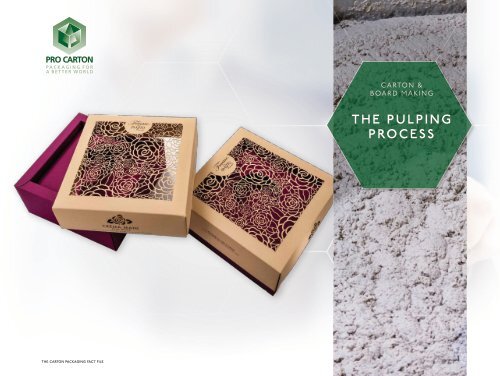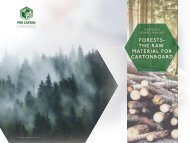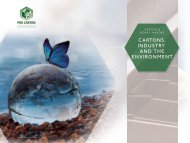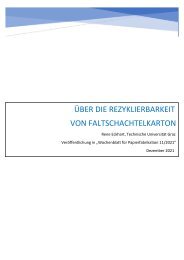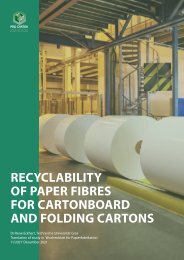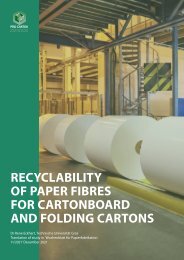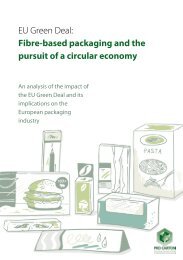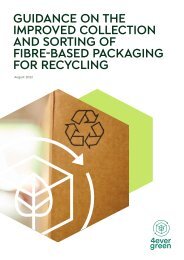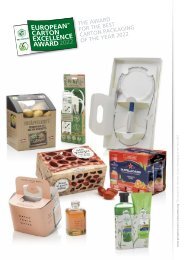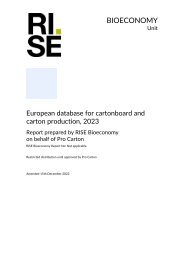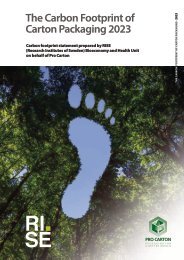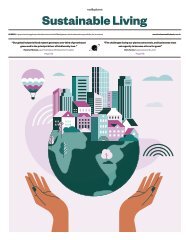Pro Carton Fact File – Module 4 – The Pulping Process
Create successful ePaper yourself
Turn your PDF publications into a flip-book with our unique Google optimized e-Paper software.
CARTON &<br />
BOARD MAKING<br />
THE PULPING<br />
PROCESS<br />
THE CARTON PACKAGING FACT FILE
WOOD PULP<br />
CARTON &<br />
BOARD MAKING<br />
Wood pulp is cellulose fibre separated from wood by “pulping”. Cellulose fibre makes up 38% - 50% of the dry<br />
weight of wood. <strong>The</strong> rest comprises of lignin, a hard brittle material which binds the fibres together,<br />
nitrocellulose and small amounts of wood resins.<br />
Fibres in spruce and pine are ribbon shaped. In dimensions they are approximately 3-4mm long and 30µm wide.<br />
<strong>The</strong>y are called “long’ fibres to distinguish them from the ”short” fibres found in birch, which are approximately<br />
1.0-1.5mm in length.<br />
THE PULPING<br />
PROCESS<br />
THE CARTON PACKAGING FACT FILE<br />
All contents copyright © BPIF 2017.
MECHANICAL PULP<br />
CARTON &<br />
BOARD MAKING<br />
<strong>The</strong> first process in pulping wood is to remove the bark, which is then either used as a horticultural product or<br />
as a source of energy in the mill.<br />
Mechanical pulping simply means that fibre separation is achieved by subjecting the wood to crushing/grinding<br />
pressure. <strong>The</strong> wood may be in the form of logs, in which case the pulp is known as “ground wood pulp”, or it<br />
may first be converted into small chips approximately 25mm square and known as “refiner mechanical pulp”.<br />
<strong>The</strong> heat generated softens the lignin and results in fibre separation. <strong>The</strong> pulp is then screened and cleaned and<br />
any remaining fibre clumps are reprocessed.<br />
Wood chips may be preheated with steam to assist the refining process in which case the pulp is known as<br />
“thermomechanical pulp” or TMP, and when limited chemical pretreatment is also applied it is called<br />
“chemi-thermomechanical pulp” or CTMP.<br />
<strong>The</strong> colour of mechanical pulp is the same as that of the wood from which it is derived. Using the option of<br />
chemical treatment reduces the amount of lignin and this results in lighter coloured pulp. In principle this<br />
treatment is a type of bleaching and the chemical treatment can be varied depending on the level of whiteness<br />
and degree of lignin reduction.<br />
THE PULPING<br />
PROCESS<br />
MECHANICAL PULP PRODUCTION<br />
Refining<br />
Spruce Timber logs Wood chips Washing process Bleaching<br />
Wood pulp<br />
Cleaning<br />
THE CARTON PACKAGING FACT FILE<br />
All contents copyright © BPIF 2017.
CHEMICAL PULP<br />
CARTON &<br />
BOARD MAKING<br />
In chemical pulping, debarked logs are chipped and treated with chemicals under heat and pressure. This process<br />
dissolves the resins which bind the fibres together in the wood. <strong>The</strong>re is a choice of chemical process. <strong>The</strong> Kraft, or<br />
Sulphate process is by far the more widely used because of its ability to process all the commonly used species of wood<br />
and its high rate of chemical recovery.<br />
THE PULPING<br />
PROCESS<br />
<strong>The</strong> Sulphate process also dissolves the non-fibrous components of the wood. In both processes the non-fibrous<br />
components are used to provide energy for pulping and for both pulp and cartonboard manufacture in integrated mills.<br />
CHEMICAL PULP PRODUCTION DIAGRAM<br />
Cooking Washing Oxygen<br />
delignification<br />
Pine<br />
or Birch<br />
Timber<br />
logs<br />
Chips<br />
Pulp<br />
Final<br />
Washing<br />
Diffuse<br />
bleaching<br />
Washing<br />
Energy generation chemical recovery<br />
THE CARTON PACKAGING FACT FILE<br />
All contents copyright © BPIF 2017.
BLEACHING<br />
CARTON &<br />
BOARD MAKING<br />
Chemically separated fibres are frequently bleached in the pulp mill to remove the last traces of lignin and any other<br />
residual material. Bleached pulp is white in appearance and pure cellulose in content even though individual fibres are<br />
colourless and translucent.<br />
Bleaching is no longer carried out with chlorine gas. Today the most widely used process is ECF (elemental<br />
chlorine free). This replaces chlorine with successive treatments of oxygen, hydrogen peroxide and chlorine<br />
dioxide. <strong>The</strong> by-products are simple and harmless and identical with compounds which occur naturally in<br />
sea water.<br />
Another process is known as TCF (totally chlorine free) where the chemicals used are oxygen and hydrogen<br />
peroxide.<br />
Whilst the use of bleached chemically separated fibre is not necessary for all grades of paper and board, it is used<br />
when specific appearance and performance needs have to be achieved. When used in cartonboard bleached fibres<br />
provide strength and durability, particularly when used in the external layers. Bleached chemical pulp has a white<br />
appearance. When used as a surface layer in the manufacture of cartonboard it can be printed, varnished, coated and<br />
laminated to achieve the required appearance.<br />
Bleached cellulose fibre is chemically pure so that it is suitable for the packaging of many products in either direct<br />
contact or in close proximity. This is particularly important where products are flavour or aroma sensitive.<br />
THE PULPING<br />
PROCESS<br />
WHAT IS MEANT BY AOX LEVEL?<br />
AOX is a measure of the organic chlorine material in the discharge from a pulp mill operating a bleaching process.<br />
Although the levels discharged from European mills are extremely low, as a result of the process changes that<br />
have been made, AOX is not a measure of environmental impact. This is because the measurement does not give<br />
any indication of the types, and hence the toxicity, of compounds which are present. <strong>The</strong> compounds present<br />
today are simple, harmless compounds with no adverse environmental effects.<br />
THE CARTON PACKAGING FACT FILE<br />
All contents copyright © BPIF 2017.
RECYCLED PULP<br />
CARTON &<br />
BOARD MAKING<br />
Recycled pulp is made from paper and board, including recovered cartonboard from recycling collection schemes.<br />
<strong>The</strong> cartonboard mills buy back the sorted material from recyclers, this is the final loop in the circular business model.<br />
Fibre separation is achieved by mechanical agitation in water. Pulp made in this way is known as recycled pulp,<br />
recycled fibre, recovered fibre, waste paper fibre or simply secondary fibre.<br />
THE PULPING<br />
PROCESS<br />
ENERGY SOURCES USED IN THE PRODUCTION OF PULP, PAPER AND CARTONBOARD<br />
Chemical pulping results in a by-product which is used as an energy source for pulping and, where appropriate,<br />
bleaching. In integrated mills, where paper or board is made at the same site, the wood by-products also provide energy<br />
in the form of electricity and steam, for the manufacturing process. This energy source is, therefore, renewable and<br />
sustainable. It accounts for around 50% of the energy consumed in pulp, paper and cartonboard manufacture.<br />
<strong>The</strong> mill operators are continuously increasing the share of renewable energy to reduce use of fossil energy sources.<br />
<strong>The</strong> mills in Scandinavia are the first to approach carbon neutrality, the ultimate target of the industry for all mills.<br />
RECYCLED PULP PRODUCTION<br />
Recovered<br />
recycling materials<br />
Hydrapulper fibre<br />
separation in water<br />
Cleaning<br />
Board<br />
machine<br />
Board<br />
THE CARTON PACKAGING FACT FILE<br />
All contents copyright © BPIF 2017.
WATER USED IN PULPING<br />
CARTON &<br />
BOARD MAKING<br />
Water is used in mechanical and chemical pulping to separate, process and transport primary or virgin fibres, i.e.<br />
fibres made directly from wood. Water is also used in the recycling of fibres from recovered paper and board.<br />
All mills have processes in place to minimise the amount of “lost water”. Water is cleaned and reprocessed in<br />
closed loops before being released back to nature.<br />
THE PULPING<br />
PROCESS<br />
In fact 90% of the water that is taken out at the beginning will be returned to the environment at the end of the<br />
process in a better and cleaner quality than before , with the remainder either being evaporated or remaining within<br />
the product. This is due to the increasing demands on European regulations forcing innovative technologies to be<br />
used in the Mills, (Cepi 2015).<br />
After use the water is treated to meet the local regulations and returned to nature. Action is being taken to moderate<br />
the amount of water used in the manufacturing process to reduce the environmental impact of water use. Cepi has<br />
stated that water consumption in European mills has been reduced by a third in the course of a 10 year survey.<br />
ADVANTAGES OF CARTONBOARD MADE FROM VIRGIN FIBRE<br />
<strong>Carton</strong>board made from primary or virgin fibre is generally whiter, smoother and has a less pronounced surface<br />
structure than cartonboard made mainly from recycled fibres. It can be up to 25% lighter for the same strength and<br />
therefore reduce the overall weight of the carton. Fibres made directly from wood are more “consistent”. This<br />
consistency means that cartonboard made from virgin fibre readily meets the needs of direct food contact and<br />
pharmaceutical packaging and wherever the products packed have sensitive flavours and aromas. One of the most<br />
sensitive products to pack is chocolate. When put in direct contact with packaging made from virgin fibres the pure<br />
taste of the chocolate will be protected.<br />
<strong>Carton</strong>board made from recycled fibre utilises valuable recovered waste paper and board which would otherwise be<br />
discarded into landfill sites or disposed of by other means. Energy and material resources are invested in the<br />
manufacture of paper and board hence recovering and recycling the fibre is therefore an efficient use of those<br />
resources. <strong>Carton</strong>board made mainly from recycled fibres can also be more cost effective as it utilises a lower cost<br />
raw material with the minimum necessary amount of more expensive virgin fibres.<br />
In order to ensure a truly circular and sustainable future for the paper and board industry it is important to continue<br />
to recover as much used fibre as possible and use virgin fibre sustainably to support developments for new and<br />
existing products. To meet varying customer requirements and to keep our circular model running we need both<br />
virgin and recovered fibres. Each post consumer carton collected and recycled will add tremendous value to our<br />
circular business model.<br />
THE CARTON PACKAGING FACT FILE<br />
All contents copyright © BPIF 2017.
HOW IS USED PAPER AND BOARD SELECTED FOR RECYCLING<br />
AS CARTONBOARD?<br />
Used paper and board is selected for recycling according to the quality of the fibre. This depends on the type of<br />
fibre and how the fibre was processed previously - whether mechanically or chemically, bleached or unbleached and<br />
whether it has already been recycled. Fibre quality will also be significantly influenced by the way the paper or board<br />
was recovered and the ways in which it was printed, converted and used.<br />
CARTON &<br />
BOARD MAKING<br />
THE PULPING<br />
PROCESS<br />
HOW IS THE QUALITY OF RECOVERED PAPER AND BOARD GRADED?<br />
Recovered paper and board is graded according to the definitions listed by Cepi and BIR published in 1999.<br />
<strong>The</strong>se describe 57 grades of recovered paper and board including several cartonboard grades. It differentiates the<br />
cartons for recycling in terms of the type of cartonboard, which takes into account the fibre composition,the extent<br />
of the print coverage, whether it is of post consumer or industrial/commercial origin and whether it is associated<br />
with other materials, such as plastic coatings.<br />
It is important that the design, manufacturing and converting of paper-based products is continued is such a way as<br />
to enable high quality recycling fibres to be sorted and recovered in an appropriate way to maximise the safe re-use<br />
of fibres.<br />
THE CARTON PACKAGING FACT FILE<br />
All contents copyright © BPIF 2017.
KEY FACTS<br />
CARTON &<br />
BOARD MAKING<br />
Cellulose fibre makes up 38% - 50% of wood. Fibres are separated from wood, waste paper and<br />
board by pulping.<br />
When wood is pulped by chemical processes, the remaining wood components are used to<br />
provide energy. About 50% of the energy used worldwide by the paper and board industry is<br />
from this naturally sustainable source.<br />
Pulp produced from wood by chemical processing is brown in colour. <strong>The</strong> bleaching process<br />
results in a chemically pure, white, pulp. Bleaching processes today do not use chlorine gas and<br />
do not produce toxic waste products.<br />
Fibres in wood can also be separated by mechanical processes. <strong>The</strong> cellulose fibres in recovered<br />
paper and board are separated by agitation in water.<br />
<strong>The</strong>re is a major difference in yield between chemical and mechanical pulp:<br />
Chemical pulp yield is around 50% with the final pulp consisting of both cellulose and<br />
hemicellulose.<br />
Mechanical pulp yield is around 90% with the final pulp consisting of cellulose, nitrocellulose<br />
and lignin.<br />
THE PULPING<br />
PROCESS<br />
THE CARTON PACKAGING FACT FILE<br />
All contents copyright © BPIF 2017.
ACKNOWLEDGEMENT<br />
CARTON &<br />
BOARD MAKING<br />
<strong>Pro</strong> <strong>Carton</strong> would like to thank the following companies for contributing both information and<br />
images to support the creation of these <strong>Fact</strong> <strong>File</strong>s:<br />
THE PULPING<br />
PROCESS<br />
THE CARTON PACKAGING FACT FILE<br />
ALL CONTENTS © PRO CARTON & UKFCA LTD. ALL STATISTICS CORRECT UP TO 2021<br />
All contents WWW.PROCARTON.COM<br />
copyright © BPIF 2017.


